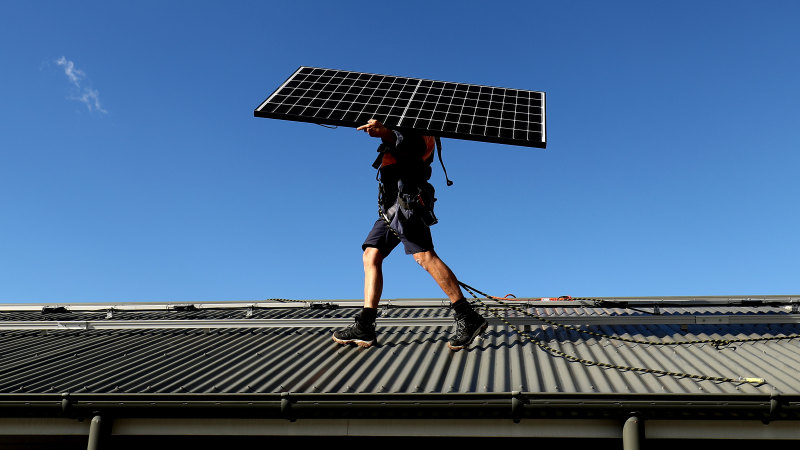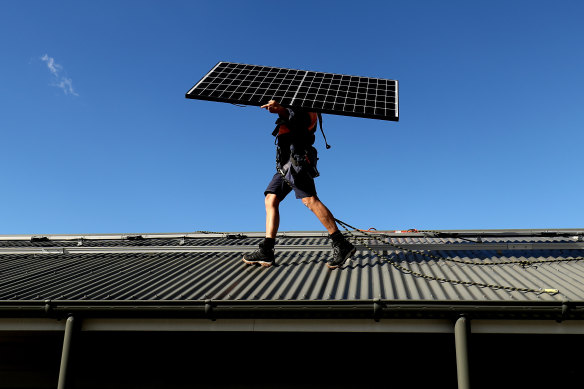Households could save up to $2000 with solar panels and batteries, data shows

Save articles for later
Add articles to your saved list and come back to them any time.
Households with rooftop solar panels can save more than $1000 a year on their electricity bills and double that amount with a home battery, according to data released by the federal government as it rejects an opposition push to pause the renewable energy rollout.
Department of Climate Change, Energy, Environment and Water analysis found rooftop solar panels would cut about 39 per cent, or $687, from the average default Victorian household electricity bill of $1756 this financial year.
One in three Australian households, or roughly 3.5 million, already have rooftop panels.Credit: Bloomberg
The addition of an 8.5 kilowatt-hour battery – to store power from the solar panels to use when the sun isn’t shining – would lift the saving to $1322, or 75 per cent.
In NSW, solar panels would reduce the average $2106 default bill by $1015, or 48 per cent, a year. An 8.5 kilowatt-hour battery would boost the discount to $2123, or 101 per cent, including earnings from feeding power from the battery back into the electricity grid.
Cost of living pressures are a key issue for the Albanese government, as rising energy prices drive up inflation and advocacy groups warn that another round of power bill relief is needed before the end of the year.
Climate Change and Energy Minister Chris Bowen said on Thursday the data highlighted the difference rooftop solar and batteries could make to household bills, while pushing back against Coalition claims it is engaging in a “reckless race to renewables”.
The government is aiming to boost the share of renewable energy in the electricity grid to 82 per cent by 2030. It is currently comprised of 63 per cent coal power, 5 per cent gas, 9 per cent hydro, 8 per cent solar and 15 per cent wind.
To achieve its target, thousands of kilometres of new transmission lines are urgently needed to link population centres with new wind and solar farms that are being built across the country.
But the rollout has stalled amid community pushback, and Opposition Leader Peter Dutton and Nationals leader David Littleproud are calling for it to be paused. They instead want the government to overturn the nation’s two-decade ban on nuclear energy and investigate the use of small modular reactors, which do not currently exist in commercial form.
Bowen has said the grid must urgently be upgraded and expanded to replace ageing infrastructure, power the growing population and boost households’ existing rooftop supplies.
The key concern is that coal is being outcompeted by cheaper wind and solar farms. NSW’s Liddell coal-fired generator in NSW closed in April and at least another seven of the remaining 14 coal plants on the eastern seaboard are due to shut within 12 years.
“Renewable energy is the cheapest form of energy and this new data highlights the real difference rooftop solar and batteries are having on household power bills,” Bowen said.
“They [the Coalition] are trying to stop Australians from accessing cleaner, cheaper energy in their homes by stopping the critical grid infrastructure needed to support households and businesses’ solar uptake.”
The relatively high price of rooftop solar and batteries prevents uptake from those most exposed to electricity costs and the federal government argues that large-scale wind and solar farms are crucial to reduce prices across the grid.
One in three, or roughly 3.5 million, Australian households already have rooftop panels. The average size of rooftop solar systems in Australia is nine kilowatts, which peak lobby group the Clean Energy Council found can be installed for between $7500 and $14,000. Smaller systems of five kilowatts can be installed for about $4000.
Only about 1.6 per cent of households with rooftop solar also have a battery, with costs for an 8.5 kilowatt system ranging from $10,000 to $14,000, including installation.
The energy market regulator, which sets retail electricity prices once a year, raised the cost of default retail contracts in June to reflect the higher input cost, pushing annual bills up by $352 in Victoria and $435 in NSW.
The government promised during the 2022 election campaign to lower power bills by $275 a year by 2025 for financially vulnerable households.
Bowen said government rebates had largely offset power price rises for most eligible households, and lowered the bills for the most financially vulnerable by 18 per cent.
However, St Vincent De Paul general manager of policy and research Gavin Dufty this week said more bill relief for vulnerable households was needed by the end of the year.
Cut through the noise of federal politics with news, views and expert analysis from Jacqueline Maley. Subscribers can sign up to our weekly Inside Politics newsletter here.
Most Viewed in Politics
From our partners
Source: Read Full Article
